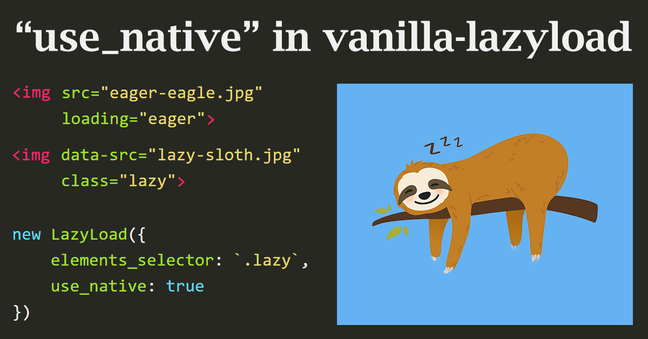Making the web faster and more user-friendly
Native lazy loading and js-based fallback with vanilla-lazyload 12
On April 6th 2019, Addy Osmany wrote about native image lazy-loading. Two days later Yvain, a front-end developer from Paris, asked me if my vanilla-lazyload could be a loading attribute polyfill, inspiring me to develop and release version 12 of the script, which features a new use_native option to enable native lazy-loading where supported. You can already use it today.

Wait... what? #
In case you missed Addy Osmani's article, it will be possible to natively lazy load images through the loading="lazy" attribute on images and iframes, and it's already possible on Chrome 75 (currently Canary).
<img loading="lazy" src="..." />
<iframe
loading="lazy"
src="..."
></iframe>Browsers will initially fetch a tiny bit of the images (~2kb) in order to get some initial information (e.g. size), then fetch the rest when they are about to enter the viewport.
The problem is that if you directly assign the src (and/or srcset) to the images, browsers that still don't support native lazy loading would download them all immediately, and this is something you might want to avoid in order to save bandwidth and speed up your website or web application.
For this reason, I added the use_native option in version 12 of vanilla-lazyload which enables native lazy-loading where supported.
More info on native lazy loading can be found on Addy Osmani's post native image lazy-loading.
The browser you need #
As of 10th April 2019, native lazy-loading is in the early stages (dev preview) and it's available only in Chrome 75 (currently Canary), and under a flag. So in order to test it, you need to:
- Download Chrome Canary and install it
- In Chrome Canary, go to the URL chrome://flags and enable the following flags:
- Enable lazy image loading
- Enable lazy iframe loading
- Restart Chrome Canary
Demo #
Now that you have the Chrome Canary browser with the native lazy loading enabled, you can get started visiting the following demo page.
→ Open the demo and/or Check the code
If you did everything correctly, that's what will happen:
- On Chrome 75 (Canary), LazyLoad will trigger the native lazy-loading
- On other browsers and older versions of Chrome, the js-based lazy loading will occur
Try it on your website! #
In order to try it yourself, you need to follow the following steps.
Markup #
To make sure that your users see your images as soon as possible, I recommend to immediately load the topmost images of your webpage, only the ones that you know that will be placed above-the-fold in the most common viewports, considering smartphones, tablets and computers.
To do that, the first images in the page should be loaded using regular <img> tags. You can use the loading="eager" attribute to make sure they load as soon as possible.
<img
src="eager-eagle.jpg"
loading="eager"
alt="Eager Eagle"
/>All other below-the-fold images should be loaded using the data-src, data-srcset and data-sizes attributes instead of src, srcset and sizes, to avoid an eager loading in browsers not supporting loading="lazy".
<img
data-src="lazy-sloth.jpg"
class="lazy"
alt="Lazy Sloth"
/>Link: for a complete guide on how to lazy load responsive images, read more about lazy loading responsive images.
Now to the Javascript code! #
You're gonna need vanilla-lazyload version 12.
You can include it via a CDN:
<script src="https://cdn.jsdelivr.net/npm/vanilla-lazyload@12.0.0/dist/lazyload.min.js"></script>Or install it using npm:
npm install vanilla-lazyload@12.0.0
In your code, set the option use_native to true when instantiating LazyLoad:
new LazyLoad({
elements_selector: `.lazy`,
use_native: true // This one
});The use_native: true flag sets up these contextual behaviors:
- where native lazy loading is supported, LazyLoad adds the
loading="lazy"attribute to the images, then just swaps thedata-*attributes for the proper ones. Now the browser will manage the lazy loading itself. - where native lazy loading is NOT supported, the lazy loading continues to be managed by Javascript, leveraging the browser's IntersectionObserver API.
To wrap up #
Loading content lazily is very important to improve a website loading speed, browser vendors are finally starting to implement it natively and I can't wait for it to be available on Edge, Safari and Firefox.
Until then, you can have both native lazy loading and js-based lazy loading using vanilla-lazyload 12, just setting the use_native option to true.
Give it a try!
If you like it, star ⭐ the repo. If you find something wrong, file an issue so I can try and fix it. For any questions, reach me on twitter.
Cheers!